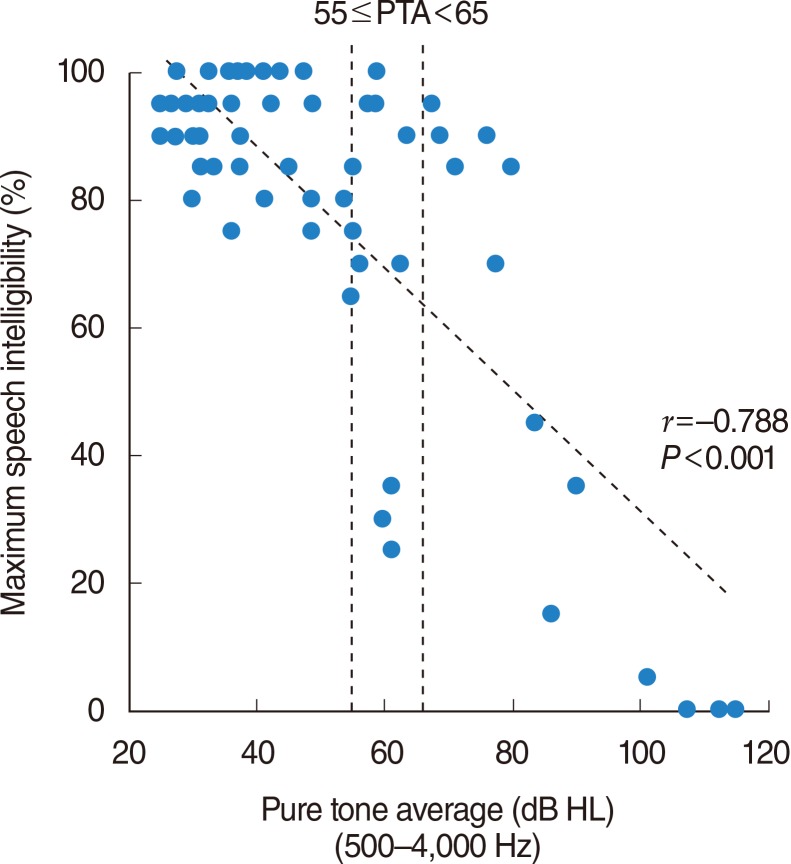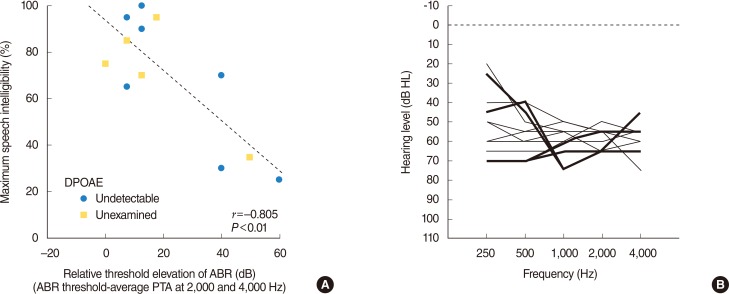1. Fletcher H. A method of calculating hearing loss for speech from an audiogram. Acta Otolaryngol Suppl. 1950; 90:26–37. PMID:
14818775.

2. Carhart R. Observations on relations between thresholds for pure tones and for speech. J Speech Hear Disord. 1971; 11. 36(4):476–483. PMID:
5125799.

3. Johnson EW. Auditory findings in 200 cases of acoustic neuromas. Arch Otolaryngol. 1968; 12. 88(6):598–604. PMID:
5724832.

4. Penrod JP. Speech threshold and word recognition/discrimination testing. In : Katz J, Gabbay WL, editors. Handbook of clinical audiology. 4th ed. Baltimore: Williams & Wilkins;1994. p. 147–164.
5. Starr A, Picton TW, Sininger Y, Hood LJ, Berlin CI. Auditory neuropathy. Brain. 1996; 6. 119(Pt 3):741–753. PMID:
8673487.

6. Kaga K, Nakamura M, Shinogami M, Tsuzuku T, Yamada K, Shindo M. Auditory nerve disease of both ears revealed by auditory brainstem responses, electrocochleography and otoacoustic emissions. Scand Audiol. 1996; 25(4):233–238. PMID:
8975994.

7. Amatuzzi M, Liberman MC, Northrop C. Selective inner hair cell loss in prematurity: a temporal bone study of infants from a neonatal intensive care unit. J Assoc Res Otolaryngol. 2011; 10. 12(5):595–604. PMID:
21674215.

8. Manchaiah VK, Zhao F, Danesh AA, Duprey R. The genetic basis of auditory neuropathy spectrum disorder (ANSD). Int J Pediatr Otorhinolaryngol. 2011; 2. 75(2):151–158. PMID:
21176974.

9. Santarelli R, Del Castillo I, Rodríguez-Ballesteros M, Scimemi P, Cama E, Arslan E, et al. Abnormal cochlear potentials from deaf patients with mutations in the otoferlin gene. J Assoc Res Otolaryngol. 2009; 12. 10(4):545–556. PMID:
19636622.

10. Liberman MC, Tartaglini E, Fleming JC, Neufeld EJ. Deletion of SLC19A2, the high affinity thiamine transporter, causes selective inner hair cell loss and an auditory neuropathy phenotype. J Assoc Res Otolaryngol. 2006; 9. 7(3):211–217. PMID:
16642288.

11. Ngo RY, Tan HK, Balakrishnan A, Lim SB, Lazaroo DT. Auditory neuropathy/auditory dys-synchrony detected by universal newborn hearing screening. Int J Pediatr Otorhinolaryngol. 2006; 7. 70(7):1299–1306. PMID:
16417926.

12. Kaga K, Iwasaki S, Tamura A, Suzuki J, Haebara H. Temporal bone pathology of acoustic neuroma correlating with presence of electrocochleography and absence of auditory brainstem response. J Laryngol Otol. 1997; 10. 111(10):967–972. PMID:
9425489.

13. Kveton JF. Delayed spontaneous return of hearing after acoustic tumor surgery: evidence for cochlear nerve conduction block. Laryngoscope. 1990; 5. 100(5):473–476. PMID:
2329903.
14. Michalewski HJ, Starr A, Nguyen TT, Kong YY, Zeng FG. Auditory temporal processes in normal-hearing individuals and in patients with auditory neuropathy. Clin Neurophysiol. 2005; 3. 116(3):669–680. PMID:
15721081.

15. Roberson JB Jr, Jackson LE, McAuley JR. Acoustic neuroma surgery: absent auditory brainstem response does not contraindicate attempted hearing preservation. Laryngoscope. 1999; 6. 109(6):904–910. PMID:
10369280.

16. Satya-Murti S, Wolpaw JR, Cacace AT, Schaffer CA. Late auditory evoked potentials can occur without brain stem potentials. Electroencephalogr Clin Neurophysiol. 1983; 10. 56(4):304–308. PMID:
6193943.

17. Starr A, McPherson D, Patterson J, Don M, Luxford W, Shannon R, et al. Absence of both auditory evoked potentials and auditory percepts dependent on timing cues. Brain. 1991; 6. 114(Pt 3):1157–1180. PMID:
2065245.

18. Takata Y, Kawase T, Nakasato N, Kanno A, Kobayashi T. Auditory evoked magnetic fields in patients with absent brainstem responses due to auditory neuropathy with optic atrophy. Clin Neurophysiol. 2012; 5. 123(5):985–992. PMID:
22119798.

19. Baldwin M, Watkin P. Predicting the degree of hearing loss using click auditory brainstem response in babies referred from newborn hearing screening. Ear Hear. 2013; May-Jun. 34(3):361–369. PMID:
23340456.

20. van der Drift JF, Brocaar MP, van Zanten GA. The relation between the pure-tone audiogram and the click auditory brainstem response threshold in cochlear hearing loss. Audiology. 1987; 26(1):1–10. PMID:
3593096.
21. Schuknecht HF, Gacek MR. Cochlear pathology in presbycusis. Ann Otol Rhinol Laryngol. 1993; 1. 102(1 Pt 2):1–16. PMID:
8420477.

22. Nadol JB Jr. Disorder of aging. In : Merchant SN, Nadol JB, editors. Schuknecht's pathology of the ear. 3rd ed. Shelton (CT): PMPH-USA;2010. p. 431–476.
23. Adams JC, Merchant SN. Disorders of intoxication. In : Merchant SN, Nadol JB, editors. Schuknecht's pathology of the ear. 3rd ed. Shelton (CT): PMPH-USA;2010. p. 353–380.
24. Merchant SN, Liberman MC. Trauma. In : Merchant SN, Nadol JB, editors. Schuknecht's pathology of the ear. 3rd ed. Shelton (CT): PMPH-USA;2010. p. 381–412.
25. Kohonen A. Effect of some ototoxic drugs upon the pattern and innervation of cochlear sensory cells in the guinea pig. Acta Otolaryngol Suppl. 1965; (Suppl 208):1–70. PMID:
4159018.
26. Ylikoski J. Correlative studies on the cochlear pathology and hearing loss in guinea-pigs after intoxication with ototoxic antibiotics. Acta Otolaryngol Suppl. 1974; 326:1–62. PMID:
4534029.
27. Schacht J, Talaska AE, Rybak LP. Cisplatin and aminoglycoside antibiotics: hearing loss and its prevention. Anat Rec (Hoboken). 012; 11. 295(11):1837–1850. PMID:
23045231.

28. Saunders JC, Dear SP, Schneider ME. The anatomical consequences of acoustic injury: a review and tutorial. J Acoust Soc Am. 1985; 9. 78(3):833–860. PMID:
4040933.

29. Merchant SN. Degeneration of auditory and vestibular end organs. In : Merchant SN, Nadol JB, editors. Schuknecht's pathology of the ear. 3rd ed. Shelton (CT): PMPH-USA;2010. p. 631–664.
30. Kiang NY, Liberman MC, Sewell WF, Guinan JJ. Single unit clues to cochlear mechanisms. Hear Res. 1986; 22(1-3):171–182. PMID:
3733538.






 PDF
PDF Citation
Citation Print
Print


 XML Download
XML Download